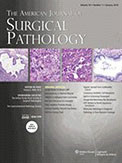Oschlies I, Burkhardt B, Chassagne-Clement C, d´Amore ES, Hansson U, Hebeda K, Mc Carthy K, Kodet R, Maldyk J, Müllauer L, Porwit A, Schmatz AI, Tinguely M, Abramov D, Wotherspoon A, Zimmermann M, Reiter A, Klapper W. Am J Surg Pathol. 2011 Jun;35(6):836–844. IF: 4.062

Abstract:
The majority of lymphoblastic (precursor cell) neoplasms presents as leukemias. Consequently, the guidelines for lineage determination and subtyping of precursor cell neoplasms were primarily established for flow cytometry methods. Large-scale studies of nonleukemic lymphoblastic lymphomas are lacking so far. We analyzed a large series of pediatric patients with lymphoblastic lymphoma treated within a prospective randomized trial (the Euro-LB 02 study). Among 193 lymphomas, in which a detailed immunohistochemical analysis was carried out, there were several unusual and diagnostically challenging morphologic and immunophenotypical variants. These included 11 lymphomas with mixed phenotypes expressing markers of at least 2 hematopoietic lineages, 7 terminal deoxynucleotide transferase-negative lymphoblastic lymphomas, and 3 undifferentiated hematopoietic neoplasms that could not be assigned to any lineage with certainty. Our data indicate that World Health Organzation guidelines for lineage determination and subtyping of precursor cell leukemia need to be adapted before they can be applied to immunohistochemical diagnosis of lymphoma. Using the experience from this cohort we suggest a resource-saving diagnostic staining panel for the immunohistochemical analysis of precursor cell neoplasms in formalin-fixed paraffin-embedded tissue.
-mk-
